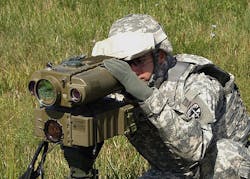Army kicks off 10-year program to build electro-optical target designation laser range finder
Officials of the Army Contracting Command at Aberdeen Proving Ground, Md., issued a presolicitation (W91CRB-18-R-0001) this week for the Lightweight Laser Designator Rangefinder (LLDR) 3 program. A formal solicitation is expected in December.
The LLDR 3 will be a man-portable, crew-served, ground-based targeting device for precision long-range target acquisition, target location, laser designation, and laser spot imaging with an all-weather day and night precision targeting capability.
It will be a modular, tripod mounted target observation, location, and designation system for forward observers as part of a fire support team, scouts, and others to execute “call-for-fire” missions including those for precision-guided, laser guided, and all other munitions.
The LLDR 3 also will help guide laser seeker-equipped aircraft to high-value targets. When connected to a forward-entry system the LLDR 3 will forward information to higher authorities.
Related: Northrop Grumman to supply Special Forces with lightweight laser target designators
The system will have three separate modules: a targeting locator module; long-range thermal imaging module; and a laser designator module.
The program will involve initial design and integration of 15 units, tested and qualified for production, no later than two years after contract award, followed by initial production and full-rate production of the LLDR 3. The program will last for 120 months, or 10 years.
As with many military technology programs, LLDR 3 requires a diminishing manufacturing sources and material shortages (DMSMS) program using a risk-based approach for electronics, commercial off-the-shelf (COTS) items, firmware, operating systems, and software. The winning contractor will take corrective actions to mitigate obsolescence.
For questions or concerns contact the Army's Karen Gibson by email at [email protected], or by phone at 410-278-5405. More information is online at http://www.fbodaily.com/archive/2017/10-October/19-Oct-2017/FBO-04715226.htm.
Ready to make a purchase? Search the Military & Aerospace Electronics Buyer's Guide for companies, new products, press releases, and videos
